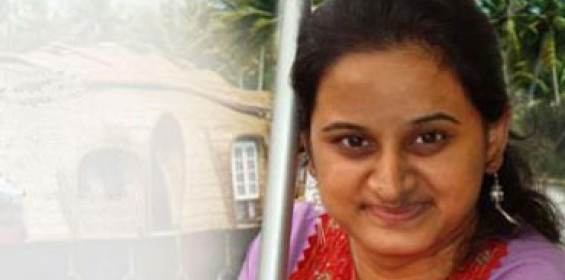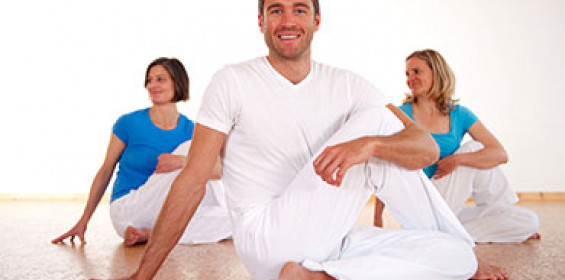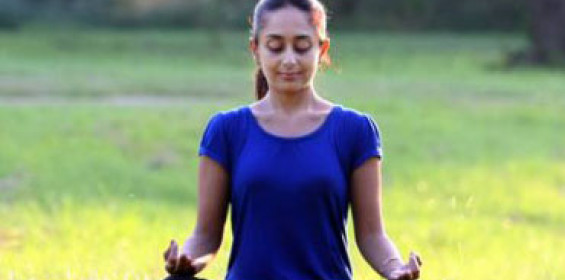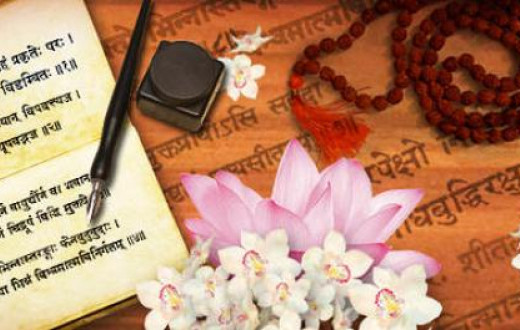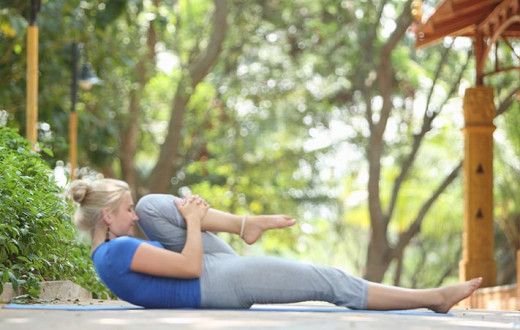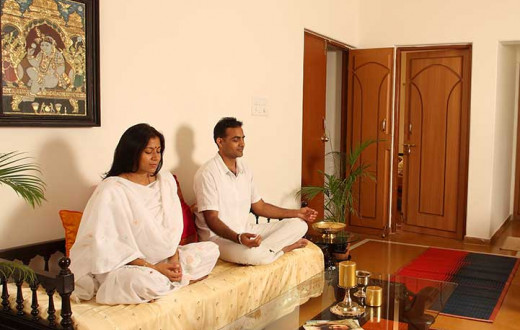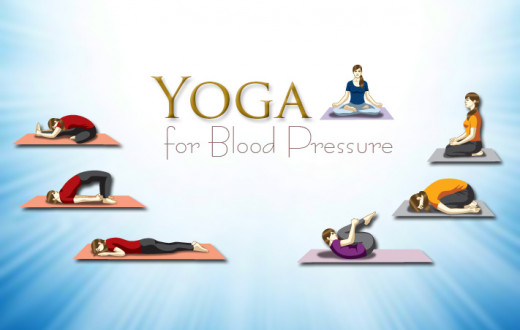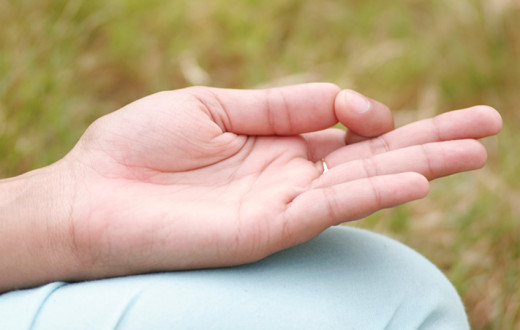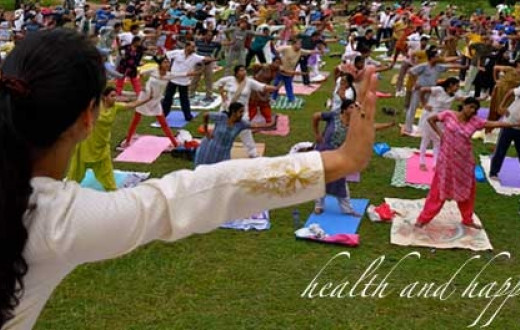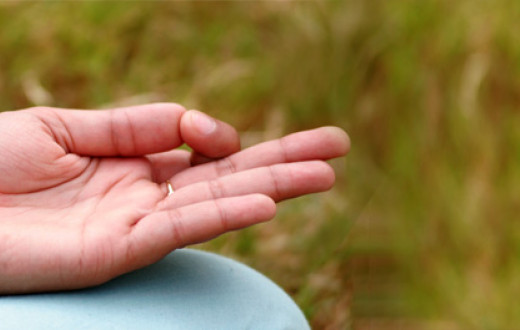Sava - Corpse; Asana - Pose
The asana is pronounced as Shuh-vah-sana
This pose gets its name from the recumbent posture of a dead body. It is a position of rest and relaxation, and is usually practiced towards the end of a yoga session – a session that typically begins with activity and ends in rest; a space or pause when deep healing can take place.

How to do the Savasana / Corpse Pose
- Lie flat on your back, preferably without any props or cushions. Use small pillow below your neck if absolutely required. Close your eyes.
- Keep your legs comfortable apart and let your feet and knees relax completely, toes facing to the sides.
- Place your arms alongside, yet a little spread apart from your body. Leave your palms open, facing upward.
- Taking your attention to different body parts one by one, slowly relax your entire body.
- Begin with bringing your awareness to the right foot, move on to the right knee (as you complete one leg, move your attention on to the other leg), and so on, and slowly move upwards to your head, relaxing each part of the body.
- Keep breathing slowly, gently, deeply and allow your breath to relax you more and more. The incoming breath energizes the body while the outgoing breath brings relaxation. Drop all sense of hurry or urgency or any need to attend to anything else. Just be with the body and the breath. Surrender the whole body to the floor and let go. Make sure you don’t fall asleep!
- After some time, about 10-20minutes when you feel fully relaxed, keeping your eyes closed, slowly roll onto your right side. Lie in that position for a minute or so. Then, taking the support of your right hand, gently sit up into a seated pose such as Sukhasana (Easy Pose).
- Keep your eyes closed and take a few deep breaths in and out as you gradually become aware of your environment and the body. When you feel complete, slowly and gently open your eyes.
Benefits of the Corpse Pose - Savasana
- This posture brings a deep, meditative state of rest, which may help in the repair of tissues and cells, and in releasing stress. It also gives time for the yoga workout to sink in at a deeper level.
- This posture leaves you in a state of rejuvenation. It is the perfect way to end a yoga session, particularly if it has been a fast-paced one.
- It helps reduce blood pressure, anxiety, and insomnia.
- This is an excellent way to ground the body and reduce the Vata dosha(imbalance of the air element) in the body.
Contraindications of the Corpse Pose - Shavasana
None (unless your doctor has advised you, for some medical reason, to avoid lying on your back).
View All - Yoga Postures lying on back
<< Lying-down on sides Lying-down Body Twist >>
Yoga practice helps develop the body and mind bringing a lot of health benefits yet is not a substitute for medicine. It is important to learn and practice yoga postures under the supervision of a trained Sri Sri Yoga teacher. In case of any medical condition, practice yoga postures after consulting a doctor and a Sri Sri Yoga teacher. Find a Sri Sri Yoga course at an Art of Living Center near you. Do you need information on courses or share feedback? Write to us at info@srisriyoga.in.
FAQ's on Shavasana
Savasana means - 'shava' means corpse and 'asana' means pose or posture. Savasana is a restorative asana that removes fatigue and gives rest to the mind.
"Savasana or corpse pose is an important restorative asana to remove fatigue and provide rest to the body and mind. Its benefits are: *repair tissues and cells *releases stress *savasana is the time when your yoga workout sinks deep in the body system. *reduce blood pressure, anxiety, and insomnia *reduce vata dosha"
"We do savasana or corpse pose for the following benefits: *repair tissues and cells *releases stress *savasana is the time when your yoga workout sinks deep in the body system. *reduce blood pressure, anxiety, and insomnia *reduce vata dosha *calms the nervous system"
"Steps for Savasana: 1. Lie down flat on your back preferably without any props. If required place a small pillow beneath the neck. Gently close your eyes. 2. Keep legs shoulder-width apart. Toes pointed outside. 3. Keep arms by your side away from your body and palms facing the sky. 4. Take attention to different parts of your body one by one starting from your right foot. 5. Just relax with every incoming and outgoing breath. 6. After around 15-20 minutes, roll on your right side for a few breaths and then sit up in sukhasana with eyes closed. 7. Become aware of the environment and the body. Whenever you feel complete, you may gently open your eyes. "
Yes, it is easy for those who can stay still without moving at all.
People who have been prescribed by the doctor not to lie on their back for some medical reason should not do savasana.
Shavasana is called a corpse pose as you lie down in the posture of a dead body. The body is so still that you are aware of the chest and abdomen rise and fall with each breath.
Twelve steps are performed in a surya namaskar.
Savasana seems to be the hardest pose for those who can't remain still even for a moment. The basic requirement of Savasana is to be still like a dead body.
You can fall asleep in Savasana in the initial days of practice. But eventually, you are required to experience restful wakefulness.
Laying down yoga pose like a dead body is called corpse pose or savasana or shavasana
Sit up tall. Back rested onto your chair. Relax the out stretched arms by your sides. Legs relax on the floor and close your eyes. Maintain the stillness of your body to avoid any distractions. Slowly thoughts quieten and rest seep in the body and mind.
Yes, Savasana is a meditative asana. Also a preparatory pose for Yog nidra meditation.
"1. Your left nostril comes on the top when you roll on the right side. This keeps your ida nadi active and your body cool and calm. 2. Your heart on the left side is free from pressure as you roll on the right side."

